|
|

| Inhabitants' name: Leccesi |
|
The civic coat of arms of the town shoes an
ilex tree with a she-wolf at its feet. Lecce was created on the rests
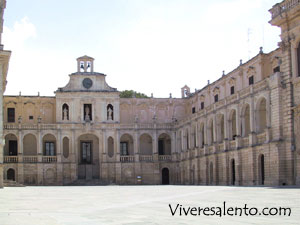 of
an old messapic town whose graves and boundaries we can still visit today.
Somebody believes the town was called Sybar but other scholars think it was only
the suburbs of Quinto Ennio’s town, Rudiae. Probably Lecce was previously called
Lupiae during the Iapigian domination. Later the name was translated in Latin
and became Licea, then evolved in Litium, Lexete and finally Lecce. In the 3rd
century the town became part of the Roman Empire and had a period of great
splendour with Emperor Marco Aurelio. Several other populations ruled the town:
Totila, the Ostrogoth conquered the town in the 6th century, then came the
Saracens, the Greeks, the Longobards, the Hungarians and the Slavs. In the 10th
century the town was ruled by the Byzantines. With the Longobard domination the
town had a decline and went through a dark period. The Normans brought it to new
splendour, Lecce of
an old messapic town whose graves and boundaries we can still visit today.
Somebody believes the town was called Sybar but other scholars think it was only
the suburbs of Quinto Ennio’s town, Rudiae. Probably Lecce was previously called
Lupiae during the Iapigian domination. Later the name was translated in Latin
and became Licea, then evolved in Litium, Lexete and finally Lecce. In the 3rd
century the town became part of the Roman Empire and had a period of great
splendour with Emperor Marco Aurelio. Several other populations ruled the town:
Totila, the Ostrogoth conquered the town in the 6th century, then came the
Saracens, the Greeks, the Longobards, the Hungarians and the Slavs. In the 10th
century the town was ruled by the Byzantines. With the Longobard domination the
town had a decline and went through a dark period. The Normans brought it to new
splendour, Lecce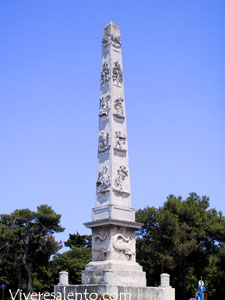 became a County and then capital of the Salento. The first count of Lecce was
Tancredi, son of the Duke Ruggero di Puglia and King of Sicily. The church of
Saint Nicolò and Cataldo was built according to his will and it is one of the
most important medieval monuments in the whole nation. Later came the Swabians
and the Angevins. In this period several families ruled the town: the first were
the Altavillas, then the Briennes. In this time many monuments were built
according to the will of Gualtiero IV, duke of Athens. Later came the Manfredis,
again to the Briennes then to the D’Enghiens, when Isabella of Brienne married
to Gualtiero D’Enghien. In the 15th century the feud was taken by the Princes of
Taranto, the Orsini del Balzos and their last heir, Giovanni Antonio, was also
the last count of Lecce. The town passed then to Ferrante of Aragon and finally
to the Bourbons who ruled the town until 1806 when the feudal system was
abolished. From the 15th century the town prospered with its cultural and
economic activities. In the Renaissance period, Charles V built the boundaries
walls, the castle and Naples Door. During the Spanish domination the artists
built those wonderful and stately buildings in perfect baroque style. In 1630
several religious buildings were started. In 1656 many people of Lecce died
became a County and then capital of the Salento. The first count of Lecce was
Tancredi, son of the Duke Ruggero di Puglia and King of Sicily. The church of
Saint Nicolò and Cataldo was built according to his will and it is one of the
most important medieval monuments in the whole nation. Later came the Swabians
and the Angevins. In this period several families ruled the town: the first were
the Altavillas, then the Briennes. In this time many monuments were built
according to the will of Gualtiero IV, duke of Athens. Later came the Manfredis,
again to the Briennes then to the D’Enghiens, when Isabella of Brienne married
to Gualtiero D’Enghien. In the 15th century the feud was taken by the Princes of
Taranto, the Orsini del Balzos and their last heir, Giovanni Antonio, was also
the last count of Lecce. The town passed then to Ferrante of Aragon and finally
to the Bourbons who ruled the town until 1806 when the feudal system was
abolished. From the 15th century the town prospered with its cultural and
economic activities. In the Renaissance period, Charles V built the boundaries
walls, the castle and Naples Door. During the Spanish domination the artists
built those wonderful and stately buildings in perfect baroque style. In 1630
several religious buildings were started. In 1656 many people of Lecce died
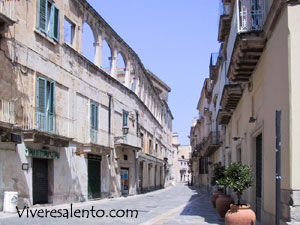 from
the plague and the town was on its knees. In 1848 during the Risorgimento, the
town was ruled by a provisional government but it was abolished short later. In
1860 people founded a liberal civic committee and as a consequence the town
became part of the Reign of Italy. Several famous people were born in Lecce:
Quinto Ennio was born in 239 B.C. and died in 169 B.C. Giuseppe Grassi was born
in 1883 and became professor in the University Of Rome. He founded the Corte
d’Appello in Lecce and the Banca del Salento (now Banca 121). He died in 1950.
Giuseppe Cino was born in 1650, became a famous architect and he created some of
the most beautiful monuments in the Salento as the Church of the Carmine in
Lecce. He died in 1722. Oronzo Massari was born in 1689. His mother forced him
to follow the Faculty of Medicine but he had a natural bent for law studies.
After he took from
the plague and the town was on its knees. In 1848 during the Risorgimento, the
town was ruled by a provisional government but it was abolished short later. In
1860 people founded a liberal civic committee and as a consequence the town
became part of the Reign of Italy. Several famous people were born in Lecce:
Quinto Ennio was born in 239 B.C. and died in 169 B.C. Giuseppe Grassi was born
in 1883 and became professor in the University Of Rome. He founded the Corte
d’Appello in Lecce and the Banca del Salento (now Banca 121). He died in 1950.
Giuseppe Cino was born in 1650, became a famous architect and he created some of
the most beautiful monuments in the Salento as the Church of the Carmine in
Lecce. He died in 1722. Oronzo Massari was born in 1689. His mother forced him
to follow the Faculty of Medicine but he had a natural bent for law studies.
After he took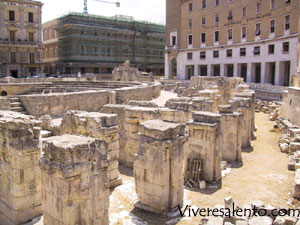 his degree in law he also became legal attorney. He worked with a good lawyer
called Francesco Rubichi. He was Major in 1950 and was beloved by all his
citizens. He died in 1967. Tito Schipa was born in 1888 in a poor family. He
studied in a Seminar and he was excellent in Music. His teacher, Alceste
Gerundi, heard him sing and decided to let him follow his own musical private
school for free. His career as a tenor began by chance: he had to take the place
of Adriana Lecouvreur because she fell sick just before the beginning of the
show. His success grew ever since and he performed also in New York and Milan.
In 1920 hew married in Lecce and he founded the Conservatory of Lecce. He died
in 1965. Luigi Giuseppe De Simone was born in 1835 and was a good judge. He was
also interested in Archaeology, History of Art, Ethnology and so on. He wrote
‘Lecce
his degree in law he also became legal attorney. He worked with a good lawyer
called Francesco Rubichi. He was Major in 1950 and was beloved by all his
citizens. He died in 1967. Tito Schipa was born in 1888 in a poor family. He
studied in a Seminar and he was excellent in Music. His teacher, Alceste
Gerundi, heard him sing and decided to let him follow his own musical private
school for free. His career as a tenor began by chance: he had to take the place
of Adriana Lecouvreur because she fell sick just before the beginning of the
show. His success grew ever since and he performed also in New York and Milan.
In 1920 hew married in Lecce and he founded the Conservatory of Lecce. He died
in 1965. Luigi Giuseppe De Simone was born in 1835 and was a good judge. He was
also interested in Archaeology, History of Art, Ethnology and so on. He wrote
‘Lecce
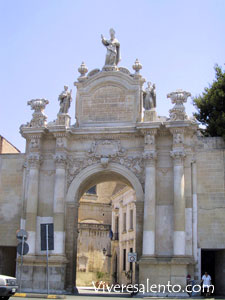 and
its monuments’ and died in Lecce in 1902. We can also remember Luigi Guacci,
born in 1871 and died in 1834. Antonio d’Andrea was born in 1808 and died in
1855. Giuseppe Zimbalo was born in 1620, was a very famous artist and died in
1710. Raffaele Protopapa was born in 1907, wrote several comedies in our dialect
and died in 1995. Giuseppe Candido was born in 1837 and died in 1906. Eugenio
Rubichi was born in 1861 and died in 1900 and many others. and
its monuments’ and died in Lecce in 1902. We can also remember Luigi Guacci,
born in 1871 and died in 1834. Antonio d’Andrea was born in 1808 and died in
1855. Giuseppe Zimbalo was born in 1620, was a very famous artist and died in
1710. Raffaele Protopapa was born in 1907, wrote several comedies in our dialect
and died in 1995. Giuseppe Candido was born in 1837 and died in 1906. Eugenio
Rubichi was born in 1861 and died in 1900 and many others.
|